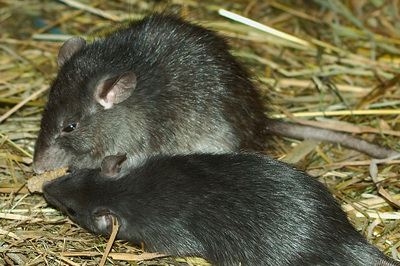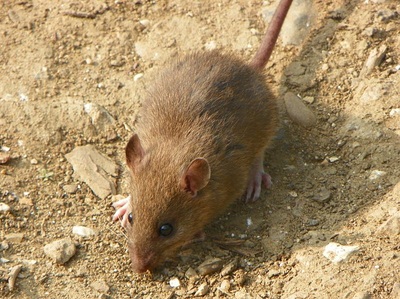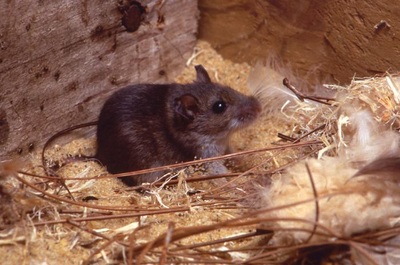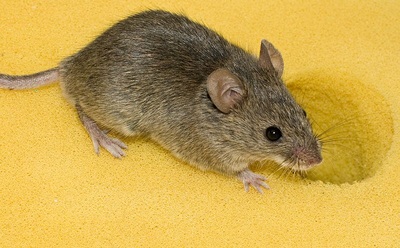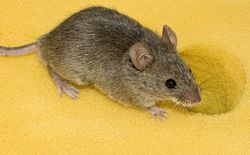
They are one of humanity's oldest enemies. They're the reason our ancestors domesticated the cat. Worldwide, they have the largest range of any animal except for humans. When they are accidentally introduced to an area, they have been responsible for the extinction of many species. They are a major vector of disease, including playing a key role in the spread of the bubonic plague in Europe, the infamous "Black Death" that killed 75 to 200 million people in the 14th century. They are by far the mammals most used in laboratories, and have contributed to many medical breakthroughs. In short, mice and rats have played an enormous role in human history.
There is a saying that an animal "breeds like bunnies" or rabbits. The phrase should, in fact, be "breeds like mice". Litters of five to six young, but sometimes as many as ten to twelve, are born after a gestation of 20 days. The resulting young, called pups, are sexually mature at 50 days old. It's not unusual for a female mouse to become pregnant again within 24 hours of giving birth. According to the AFRMA (American Fancy Rat and Mouse Association), a single male and female pair, given optimal conditions, can multiply and become 131,258 mice within 51 weeks. By week 60, that number goes over a million. (Don't try this at home!)
This incredible rate of reproduction, as well as a high level of adaptivity to living around humans, means that they can be rather hard to get rid of if they decide to make your home their own. Some people have had success getting rid of these furry unwanted houseguests using products they've purchased themselves. However, for others, it's just best to pay the piper and call in a professional.
WHAT YOU CAN DO
Do not leave food items out for an extended period of time. Keep grain and sugar products in airtight containers (this will also make the food last longer before spoiling). Look for and close up any potential entry points on the inside or outside of your house (a mouse can get through a hole the size of a dime; a rat a hole the size of a quarter -- pay special attention to the areas around pipes and under sinks, as these are places that holes tend to appear).
OUR TREATMENT
We have a variety of options available for rodent control. Our first, and favorite, method is via the use of bait -- poisoned bait is placed in a tamper-resistant box that's safe to have around children and pets, and then placed around known areas of activity. The second method is by using snap traps, although the models we use are safe to have around little fingers and inquisitive pets. We also use glueboards -- paper boards with glue one one side, that the rodent will get stuck on. This method is less humane, but sometimes necessary.
There is a saying that an animal "breeds like bunnies" or rabbits. The phrase should, in fact, be "breeds like mice". Litters of five to six young, but sometimes as many as ten to twelve, are born after a gestation of 20 days. The resulting young, called pups, are sexually mature at 50 days old. It's not unusual for a female mouse to become pregnant again within 24 hours of giving birth. According to the AFRMA (American Fancy Rat and Mouse Association), a single male and female pair, given optimal conditions, can multiply and become 131,258 mice within 51 weeks. By week 60, that number goes over a million. (Don't try this at home!)
This incredible rate of reproduction, as well as a high level of adaptivity to living around humans, means that they can be rather hard to get rid of if they decide to make your home their own. Some people have had success getting rid of these furry unwanted houseguests using products they've purchased themselves. However, for others, it's just best to pay the piper and call in a professional.
WHAT YOU CAN DO
Do not leave food items out for an extended period of time. Keep grain and sugar products in airtight containers (this will also make the food last longer before spoiling). Look for and close up any potential entry points on the inside or outside of your house (a mouse can get through a hole the size of a dime; a rat a hole the size of a quarter -- pay special attention to the areas around pipes and under sinks, as these are places that holes tend to appear).
OUR TREATMENT
We have a variety of options available for rodent control. Our first, and favorite, method is via the use of bait -- poisoned bait is placed in a tamper-resistant box that's safe to have around children and pets, and then placed around known areas of activity. The second method is by using snap traps, although the models we use are safe to have around little fingers and inquisitive pets. We also use glueboards -- paper boards with glue one one side, that the rodent will get stuck on. This method is less humane, but sometimes necessary.
Unless otherwise indicated, all photos are courtesy Wikimedia Commons or the US Centers for Disease Control and Prevention.

